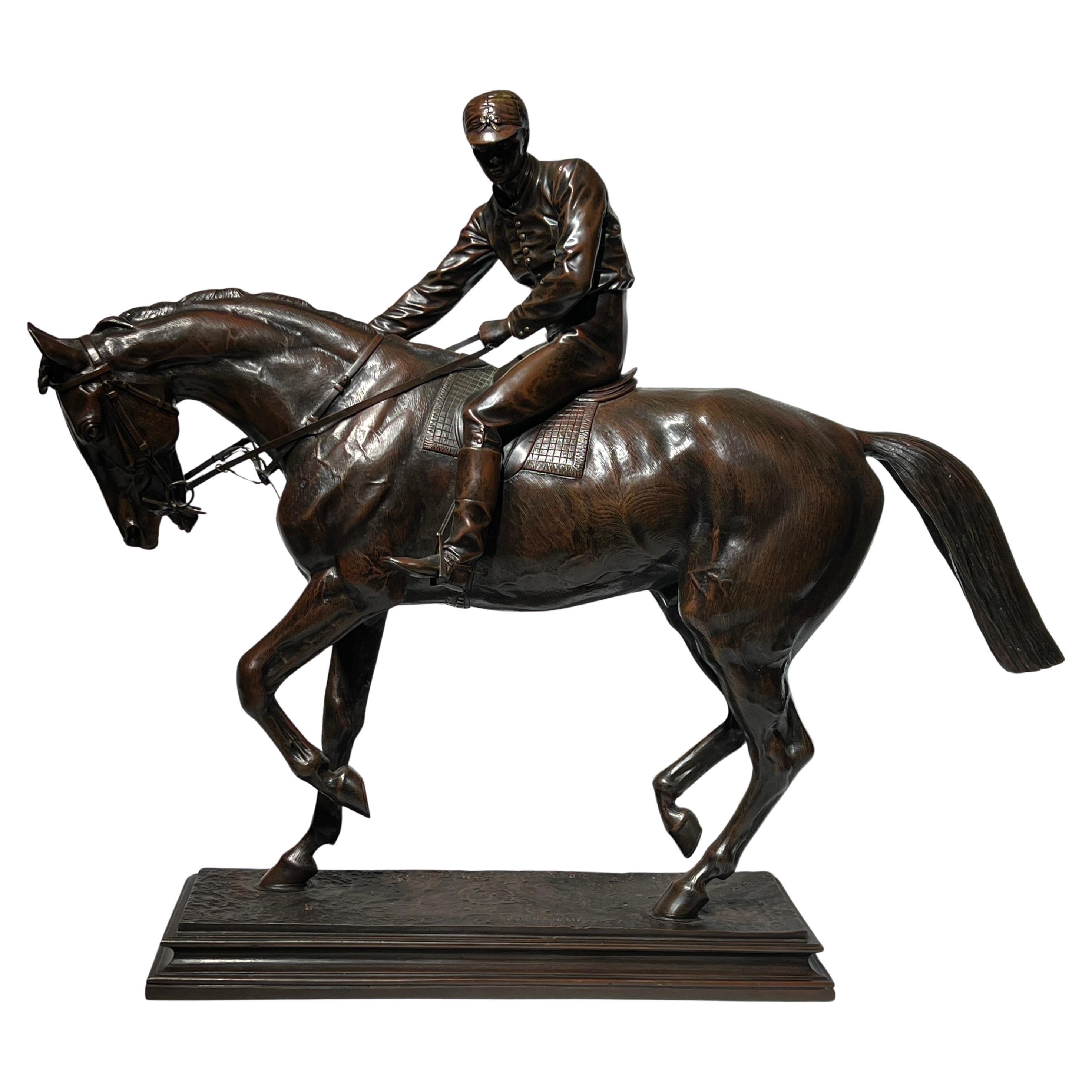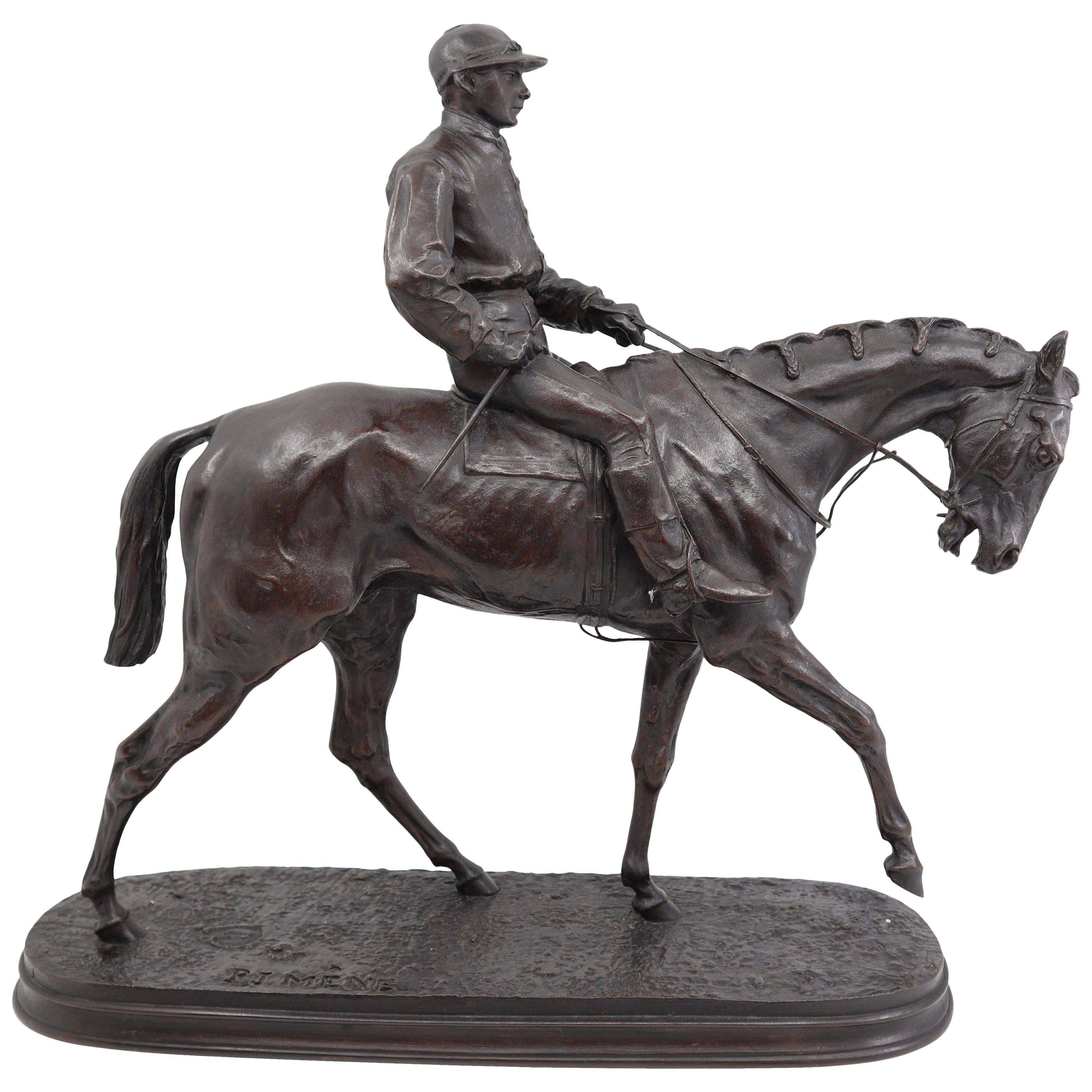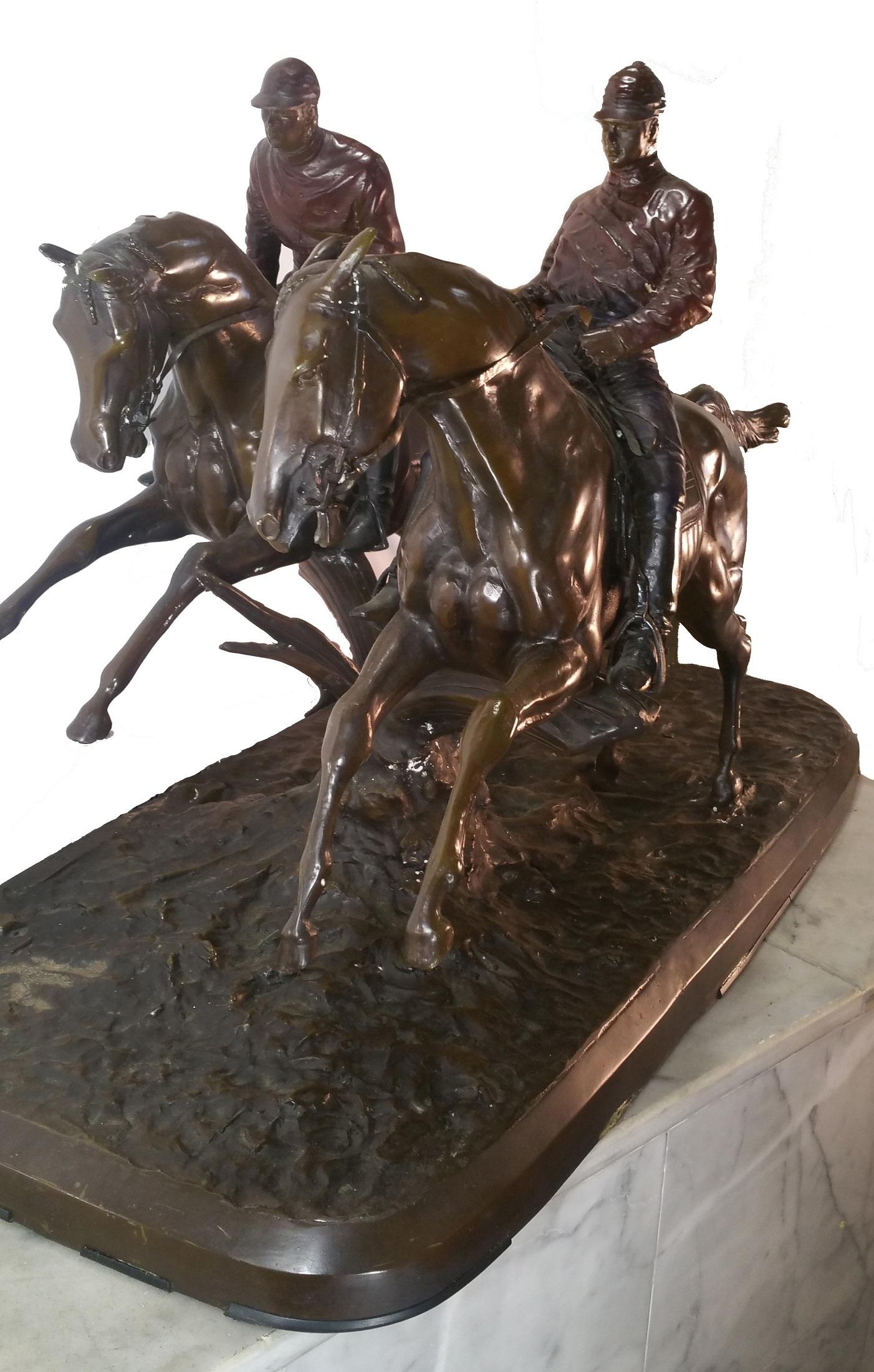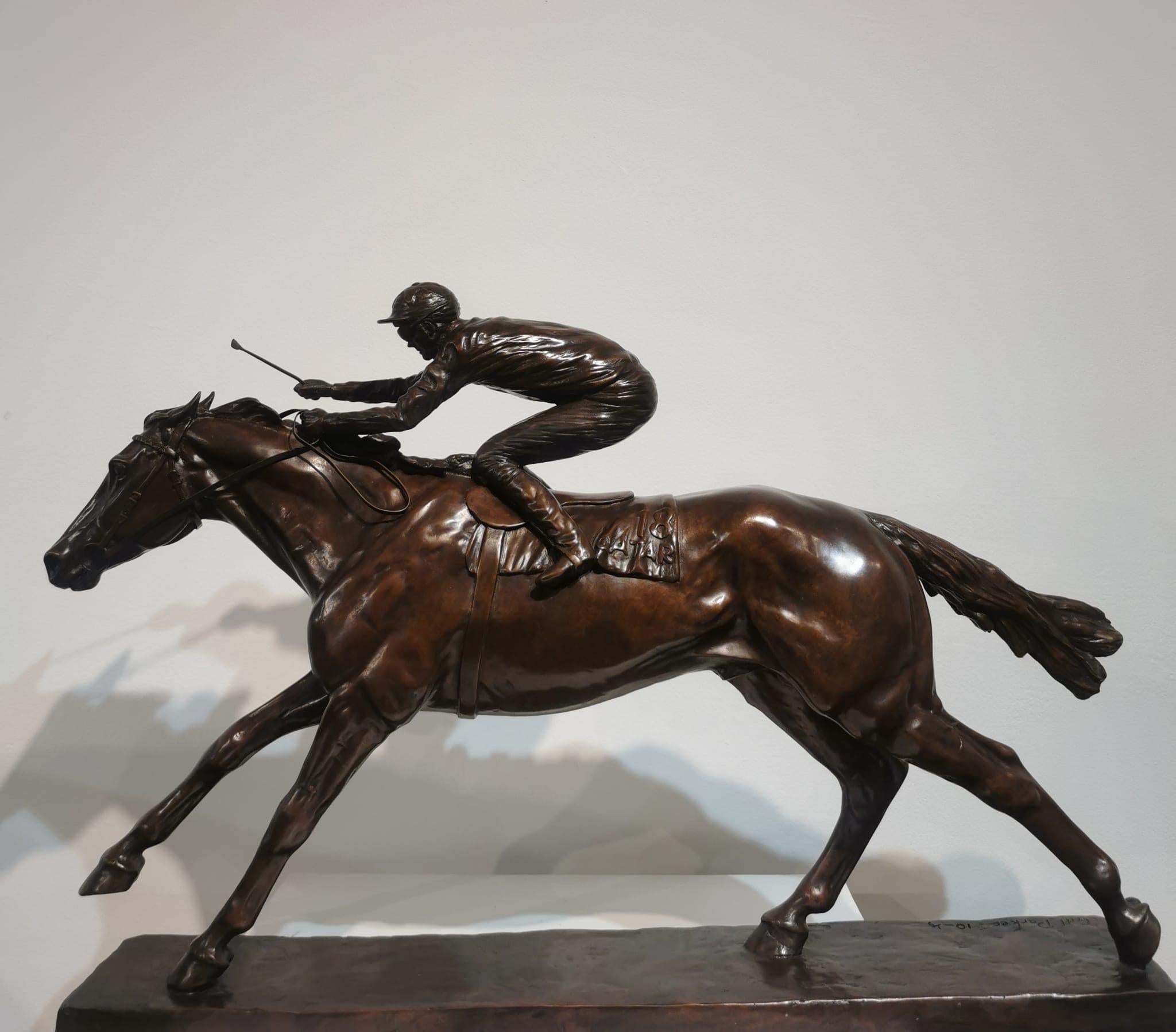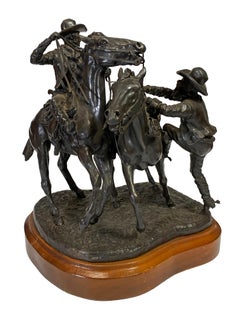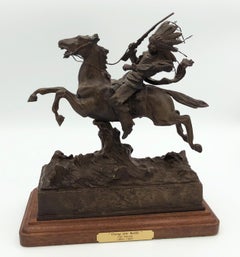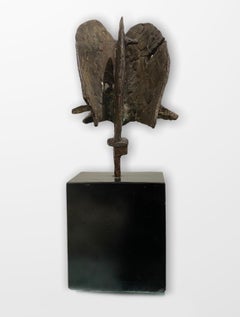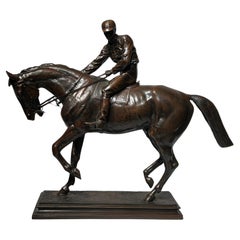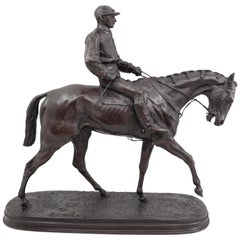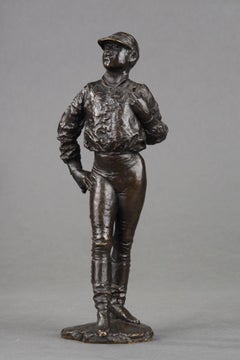Items Similar to Jockey On Horseback
Want more images or videos?
Request additional images or videos from the seller
1 of 6
Hans GuradzeJockey On Horsebackc. 1900
c. 1900
Price Upon Request
Price Upon Request
Price Upon Request
Price Upon Request
Price Upon Request
Price Upon Request
Price Upon Request
Price Upon Request
Price Upon Request
Price Upon Request
About the Item
Hans Guradze (German, 1861-1922)
"Jockey On Horseback"
Bronze
Approx. 19.5 x 17 x 6 inches
Signed "H. Guradze Berlin" on Base
About the Seller
5.0
Vetted Professional Seller
Every seller passes strict standards for authenticity and reliability
Established in 1970
1stDibs seller since 2017
155 sales on 1stDibs
Typical response time: 1 to 2 days
- ShippingRetrieving quote...Shipping from: Missouri, MO
- Return Policy
Authenticity Guarantee
In the unlikely event there’s an issue with an item’s authenticity, contact us within 1 year for a full refund. DetailsMoney-Back Guarantee
If your item is not as described, is damaged in transit, or does not arrive, contact us within 7 days for a full refund. Details24-Hour Cancellation
You have a 24-hour grace period in which to reconsider your purchase, with no questions asked.Vetted Professional Sellers
Our world-class sellers must adhere to strict standards for service and quality, maintaining the integrity of our listings.Price-Match Guarantee
If you find that a seller listed the same item for a lower price elsewhere, we’ll match it.Trusted Global Delivery
Our best-in-class carrier network provides specialized shipping options worldwide, including custom delivery.More From This Seller
View AllPreparing to Ride
Located in Missouri, MO
Preparing to Ride
By. George B. Marks (American, 1923-1983)
Signed and Dated
Throughout his artistic career, George Marks’s work was always guided by the...
Category
1970s American Realist Figurative Sculptures
Materials
Bronze
Price Upon Request
The Hunter and Hound
By Pierre Jules Mêne
Located in Missouri, MO
Pierre-Jules Mene
"The Hunter and Hound" (Le Valet de Limier) 1879
Bronze
approx. 19 x 8 x 14 inches
Signed
PIERRE JULES MENE (1810-1879)
Pierre...
Category
1870s Realist Figurative Sculptures
Materials
Bronze
Price Upon Request
Going into Battle
By Carl Kauba
Located in Missouri, MO
Carl Kauba
"Going into Battle" c. 1920s
Bronze with Brown Patina
Signed
approx 10 x 10 x 4 (including wooden base)
This Austrian sculptor was born in Vienna in 1865. His teachers were Karl Waschmann (1848-1905), known for his ivory sculptures and portrait plaquettes of contemporary celebrities, and Stefan Schwartz (1851-1924), who exhibited in Paris, including the Exposition Universelle of 1900 where he won a gold medal. Kauba's intricate bronzes, imported to the United States between 1895 and 1912, were cast at the Roman Bronze Works. Kauba was part of the nineteenth-century tradition of polychrome bronze sculpture. There were several types of patinas on a single statue: he could render the color of buckskin, variously tinted shirts, blankets, feathers, as well as beaded moccasins. Reportedly, Kauba came to America around 1886. Inspired by the Western tales of German author Karl May, he traveled to the West and made sketches and models. Critics, however, pointed out inaccuracies of costume and other details. For instance, the guns that his "mid-nineteenth-century" figures use are models produced after 1898. Apparently he did all of his works back in Vienna.
Besides the variety of color, Kauba's bronzes show a great range of textures and his style is highly naturalistic. The sculptor loved ornament, some of which he rendered with coiled wire for reins, rope and feathers in headdresses. He successfully rendered figures in motion and often executed compositions with more than one figure. Berman (1974) illustrates non-Western subjects by Kaula, such as the pendants Where? and There (ca. 1910), a seated Scottish couple, impressive in the expressions and the details on patterned fabrics of both sitters. Another genre piece is Buster Brown...
Category
Early 20th Century Realist Figurative Sculptures
Materials
Bronze
Price Upon Request
Piccolo Guerriero (Little Warrior)
By Luciano Minguzzi
Located in Missouri, MO
Luciano Minguzzi (Italian, 1911-2004)
Piccolo Guerriero (Little Warrior) c. 1950s
Bronze
Monogrammed and Numbered 1/5
Height From Base to Top: approx. 12" High
Bronze: 6 3/4 inches x 4W x 3D
Luciano Minguzzi was born in Bologna in 1911 and died in Milan in 2004. In 1943 he took part in the Fourth Quadrennial of Rome. In 1950 he was awarded the grand prize for sculpture at the XXV Venice Biennale, and attended again in 1952.
His works can be found at Museum of the Fabbrica del Duomo, in the Museum of Modern Art in the Vatican and in the Galleries of Modern Art in Rome, Milan, Bologna, Florence, Trieste, Verona, Carrara, Padova, as well as abroad and overseas.
Additional Biography (translated from Italian):
Luciano Minguzzi ( Bologna , 24 May 1911 - Milan , 30 May 2004 ) was a sculptor and medalist Italian .
Image of the exhibition Luciano Minguzzi: sculptures and gouaches 1950-1970 in the Romanesque cloister of the Cathedral of Prato ( Museo dell'Opera del Duomo ), 24 April - 24 May 1971. Photo by Paolo Monti .
Index:
He made his first experiences under the wise guidance of his father, also a sculptor , continuing his studies at the Academy of Fine Arts in Bologna following the engraving courses held by Giorgio Morandi , those of sculpture under the guidance of Ercole Drei , attending at ' university the lessons Roberto Longhi.
Thanks to a scholarship, he stayed in Paris and London , starting to exhibit in 1933 and already at the Roman Quadrennial of 1943 he obtained his first prize, which was followed by others including the Angelicum of 1946 and the first place ex aequo at the Biennale del 1950.
Immediately after the war he created the monument to the Partisan and the Partisan for his hometown , located near Porta Lame , in the area where an epic battle between Nazi-Fascists and partisans took place in 1944 .
The work, composed of two figures of young people - one of which armed - caught in a moment of great naturalness, was forged with cast bronze from the equestrian statue of Benito Mussolini (by Giuseppe Graziosi ) which was located inside the current "Renato Dall'Ara" Stadium, in turn made with some cannons stolen from the Austrians during the Bolognese Risorgimento uprisings of 1848.
Still on the theme linked to war , but with a changed style with more dramatic and expressionist tones , in the fifties he created a series of sculptures inspired by the theme of the men of the Lager and the unknown and anonymous victims, obtaining in 1953 the third prize in the competition for the "Monument to the Unknown Political Prisoner " announced by the Tate Gallery ( London ).
In 1950 he won the competition for the "Quinta Porta" of the Milan Cathedral , completed in 1965 .
In 1962 he participated, together with the most important international sculptors of the time, in the exhibition Sculptures in the city organized by Giovanni Carandente as part of the V Festival dei Due Mondi in Spoleto . He presented a 1958 iron and bronze sculpture entitled Pas-de-quatre.
In 1970 he was given the task of building the "Door of good and evil" of the basilica of St. Peter in the Vatican , on which he worked with vigor and passion for seven years.
In 2012, on the occasion of the centenary of the artist's birth, a posthumous anthological exhibition was set up in Bologna at the Fondazione del Monte [1] .
He also worked as a medalist: his example is the silver 500 lire coin...
Category
Mid-20th Century Modern Abstract Sculptures
Materials
Bronze
Price Upon Request
The Holdup of the Overland Stagecoach
By Gordon Phillips
Located in Missouri, MO
The Holdup of the Overland Stagecoach
By. Gordon Phillips (American, 1927-2011)
Initialed and Edition 493/750
Gordon Phillips was born in 1927 in Boone, North Carolina. He studied a...
Category
20th Century American Realist Figurative Sculptures
Materials
Metal
Price Upon Request
The Encounter
By Ernest Trova
Located in Missouri, MO
Ernest Trova
"The Encounter" 1994
Chrome Plated Steel
Approx 24 x 26 x 24 inches
Edition 1/8
Known for his Falling Man series in abstract figural sculpture, he created hard-edge ima...
Category
1990s American Modern Figurative Sculptures
Materials
Stainless Steel
Price Upon Request
You May Also Like
Jockey Winner
By Isidore Jules Bonheur
Located in PARIS, FR
Jockey Winner
by Isidore BONHEUR (1827-1901)
A rare and magnificent bronze group with a dark brown patina
Signed on the base "I. Bonheur"
A period cast by "Peyrol" (with the foundry stamp)
Standing on a molded wooden base
France
circa 1880
height of the bronze : 53,5 cm
total height with the base : 62 cm
total length : 68 cm
depth : 24 cm
Biography:
Isidore Jules Bonheur (1827-1901) was a French painter and sculptor. Isidore first received an artistic apprenticeship from his father Raymond and his older sister Rosa, then, in 1827, he entered the School of Fine Arts in Paris. After practicing...
Category
1880s French School Figurative Sculptures
Materials
Bronze
Large Bronze Sculpture of a Jockey on Thoroughbred by Isidore Jules Bonheur
By Isidore Jules Bonheur
Located in New York, NY
An exceptional casting and finely patinated bronze sculpture of jockey on thoroughbred racehorse by Isidore Jules Bonheur (1827-1901), measuring 24 in tall, 26 in wide and 6 in deep....
Category
Antique Late 19th Century French Figurative Sculptures
Materials
Bronze
French Bronze Jockey on Horse by Pierre Jules Mêne
By Pierre Jules Mêne
Located in Lantau, HK
A self-taught artist, Piere-Jules Mêne (1810-1879) dedicated his entire career to making bronze statues, which were met with great success among both French and international clients...
Category
Antique 19th Century French Animal Sculptures
Materials
Bronze
Elegant standing Jockey
Located in PARIS, FR
Elegant standing Jockey
by Francesco de Matteis (1852-1917)
Bronze with nuanced brown patina
Signed on the base " F. de Matteis "
Old edition cast
Italy
circa 1890
height 21 cm
w...
Category
Late 19th Century Italian School Figurative Sculptures
Materials
Bronze
Mounted Jockeys Taking a Jump
Located in Saratoga Springs, NY
Bronze (After) Henri (Comte) Geoffroy De Ruille, Mounted Jockeys (French 1842-1922)
"Mounted Jockeys Taking a Jump"
40"long x 26" high x 20 ½" wide
20th Century
Medium: Patinaed B...
Category
Mid-20th Century Academic Figurative Sculptures
Materials
Bronze
'See The Stars' Limited edition Bronze equestrian sculpture
Located in Tetbury, GB
A stunning Bronze sculpture depicting the champion race horse 'See The Stars'.
The work is part of a Bronze world edition of just 9 by leading British equestrian sculptor Gill Park...
Category
2010s Contemporary Figurative Sculptures
Materials
Bronze
More Ways To Browse
Antique Jockey
Jockey Sculpture
Bronze Jockey
Magda Gluszek
Mai Accents
Male Nude Figurines
Marble Shark Sculpture
Mark Chatterley
Martin Duque
Melting Popsicle
Mexican Clay Nativity
Michael Joplin
Michael Wilkinson Sculptures Acrylic Sculpture
Michelle Gregor
Miguel Guia Calm And Silence
Miguel Guia Sculpture
Miguel Guia
Nam Tran
